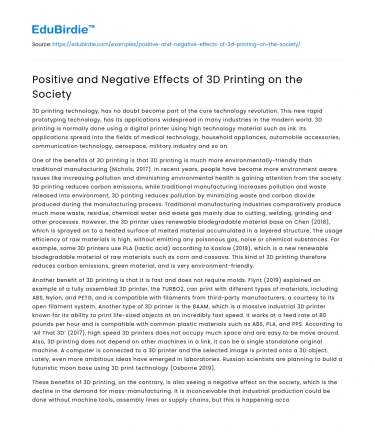3D printing technology, has no doubt become part of the core technology revolution. This new rapid prototyping technology, has its applications widespread in many industries in the modern world. 3D printing is normally done using a digital printer using high technology material such as ink. Its applications spread into the fields of medical technology, household appliances, automobile accessories, communication technology, aerospace, military industry and so on.
One of the benefits of 3D printing is that 3D printing is much more environmentally-friendly than traditional manufacturing (Nichols, 2017). In recent years, people have become more environment aware. Issues like increasing pollution and diminishing environmental health is gaining attention from the society. 3D printing reduces carbon emissions, while traditional manufacturing increases pollution and waste released into environment, 3D printing reduces pollution by minimizing waste and carbon dioxide produced during the manufacturing process. Traditional manufacturing industries comparatively produce much more waste, residue, chemical water and waste gas mainly due to cutting, welding, grinding and other processes. However, the 3D printer uses renewable biodegradable material base on Chen (2018), which is sprayed on to a heated surface of melted material accumulated in a layered structure. The usage efficiency of raw materials is high, without emitting any poisonous gas, noise or chemical substances. For example, some 3D printers use PLA (lactic acid) according to Koslow (2019), which is a new renewable biodegradable material of raw materials such as corn and cassava. This kind of 3D printing therefore reduces carbon emissions, green material, and is very environment-friendly.
Save your time!
We can take care of your essay
- Proper editing and formatting
- Free revision, title page, and bibliography
- Flexible prices and money-back guarantee
Another benefit of 3D printing is that it is fast and does not require molds. Flynt (2019) explained an example of a fully assembled 3D printer, the TURBO2, can print with different types of materials, including ABS, Nylon, and PETG, and is compatible with filaments from third-party manufacturers, a courtesy to its open filament system. Another type of 3D printer is the BAAM, which is a massive industrial 3D printer known for its ability to print life-sized objects at an incredibly fast speed. It works at a feed rate of 80 pounds per hour and is compatible with common plastic materials such as ABS, PLA, and PPS. According to ‘All That 3D’ (2017), high speed 3D printers does not occupy much space and are easy to be move around. Also, 3D printing does not depend on other machines in a link, it can be a single standalone original machine. A computer is connected to a 3D printer and the selected image is printed onto a 3D object. Lately, even more ambitious ideas have emerged in laboratories. Russian scientists are planning to build a futuristic moon base using 3D print technology (Osborne 2019).
These benefits of 3D printing, on the contrary, is also seeing a negative effect on the society, which is the decline in the demand for mass-manufacturing. It is inconceivable that industrial production could be done without machine tools, assembly lines or supply chains, but this is happening according to Redwood (2019). 3D printing technology be used at a small scale and can be customized according to specific needs. 3D printing can also reduce production quality problems compared to traditional factory production. It is often used to make custom-made, improved versions of products quickly and cheaply compared to mass production. It sometimes even makes industrially impossible manufacturing possible. A 3D printer can make a wide variety of products and sometimes even print them into a shape without assembly. It's a workshop without a workshop, starting a new generation of do-it-yourself makers. As it is flexible and fast, no inventory is required. Mazzarol (2012) says that “if such technologies become mainstream, it is possible that the existing low-cost manufacturing industries in countries like China, may soon diminish”.
Another positive effect of 3D printing on the society (Ventola 2014) is its influence in future medical technology revolution. Medical props, models, consumables and other materials can be manufactured through 3D printing. Using 3D printing technology, computer image data can be transformed into solid structure for medical learning purposes and operation practice. 3D printing can create new body parts, such as antibacterial tooth, human bones, ovary or even heart and so on. Base on Murphy (2018), 3D printing technology can produce clones for damaged facial tissues, such as ear, nose and skin, etc. It can elegantly build corresponding tissues exactly matching patients’ bodies. It can effectively reconstruct the complete image of patients' heads and achieve aesthetic effects. The process involves initial scanning of the person’s face using a 3D computer and then image date is used by doctors to reconstruct parts of the patient that are missing. Compared to traditional techniques, this method is much more accurate and the material selection is more diversified. With the increase of materials supported by 3D printing technology and the refinement of printing quality, expansion of beauty market, application of facial modification and beauty industries will grow drastically. According to ABC (2019), for the first time in the world, a whole heart was printed on a 3D printer using biological materials.
3D printing technology is a major game changer to the traditional manufacturing technology, which slowly changes our lifestyle, and also plays an extremely crucial role in creative design, biological and medical fields. It can affect countries like China, a big manufacturing country, as demand for mass-manufacturing would decline and reduce job opportunities. Despite these negative effects, its positive effects on the society are outweighed. The most exciting effect of its applications on society is its use in health and medical fields. Maybe within a decade, the best hospitals in the world will have organ printers, making organ and tissue printing a routine operation.






 Stuck on your essay?
Stuck on your essay?

